学术英语写作教案 语言学共26页
- 格式:ppt
- 大小:2.79 MB
- 文档页数:26

英语写作课教案设计English writing courses are crucial for students to develop their writing skills, which are essential for academic and professional success. Designing an effective lesson plan for an English writing course requires careful consideration of various factors, including the students' level of proficiency, learning objectives, and appropriate instructional strategies. This lesson plan aims to provide a comprehensive framework for teaching English writing to students, fostering their ability to express themselves clearly and effectively in written form.The lesson should begin with a warm-up activity to engage students and activate their prior knowledge. This could involve a brief discussion or a writing prompt related to a familiar topic, allowing students to share their thoughts and ideas. The warm-up activity should be designed to create a supportive learning environment and encourage active participation from all students.Next, the teacher should introduce the lesson's objectives and outline the main writing skills or concepts that will be covered. This could include elements such as paragraph structure, essay organization, sentence construction, or specific writing genres likenarrative, expository, or persuasive writing. Providing clear learning goals will help students understand the purpose and relevance of the lesson.The lesson should then transition into direct instruction, where the teacher presents the key writing concepts and strategies. This can be done through a combination of lecture, multimedia presentations, and modeling examples. It is important to use clear and concise language, provide visual aids, and regularly check for student understanding through questioning and formative assessments.After the direct instruction phase, students should be given ample opportunities for guided practice. This could involve various writing activities or exercises that allow them to apply the taught concepts and strategies under the teacher's supervision. During this phase, the teacher should provide feedback, address common errors or misconceptions, and offer individualized support to students who may be struggling.Collaborative learning activities, such as peer editing or group writing tasks, can also be incorporated into the lesson plan. These activities promote social interaction, encourage critical thinking, and allow students to learn from one another's strengths and perspectives. Additionally, they can foster essential skills like constructive feedback, teamwork, and communication.Throughout the lesson, the teacher should emphasize the importance of the writing process, including prewriting, drafting, revising, and editing. Students should be encouraged to view writing as an iterative process rather than a one-time task, and they should be provided with strategies for effective revision and self-editing.Towards the end of the lesson, students should be given an opportunity to apply their newly acquired knowledge and skills by engaging in an independent writing task. This could be a short essay, a creative writing piece, or a reflective journal entry. The teacher should provide clear instructions, rubrics, and guidelines to support students during this phase.Finally, the lesson should conclude with a reflection and assessment component. Students could share their writing with the class, receive peer feedback, or engage in a class discussion about their learning experiences. The teacher should also provide summative feedback and assess students' understanding of the lesson's objectives, identifying areas for further reinforcement or enrichment.Throughout the lesson, it is essential to incorporate differentiated instruction to cater to the diverse needs and learning styles of students. This could involve providing additional scaffolding or support materials for struggling learners, offering extension activitiesfor advanced students, or incorporating various instructional strategies such as visual aids, hands-on activities, or technology integration.By following this comprehensive lesson plan, teachers can effectively guide students through the intricacies of English writing, fostering their ability to express themselves clearly, coherently, and creatively in written form. Consistent practice, constructive feedback, and a supportive learning environment will enable students to develop the writing skills necessary for academic and professional success.。
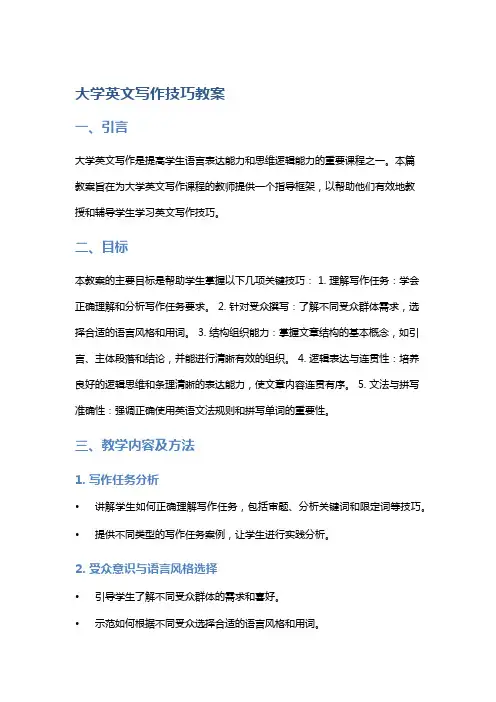
大学英文写作技巧教案一、引言大学英文写作是提高学生语言表达能力和思维逻辑能力的重要课程之一。
本篇教案旨在为大学英文写作课程的教师提供一个指导框架,以帮助他们有效地教授和辅导学生学习英文写作技巧。
二、目标本教案的主要目标是帮助学生掌握以下几项关键技巧: 1. 理解写作任务:学会正确理解和分析写作任务要求。
2. 针对受众撰写:了解不同受众群体需求,选择合适的语言风格和用词。
3. 结构组织能力:掌握文章结构的基本概念,如引言、主体段落和结论,并能进行清晰有效的组织。
4. 逻辑表达与连贯性:培养良好的逻辑思维和条理清晰的表达能力,使文章内容连贯有序。
5. 文法与拼写准确性:强调正确使用英语文法规则和拼写单词的重要性。
三、教学内容及方法1. 写作任务分析•讲解学生如何正确理解写作任务,包括审题、分析关键词和限定词等技巧。
•提供不同类型的写作任务案例,让学生进行实践分析。
2. 受众意识与语言风格选择•引导学生了解不同受众群体的需求和喜好。
•示范如何根据不同受众选择合适的语言风格和用词。
3. 文章结构组织•解释文章结构基本概念:引言、主体段落和结论。
•提供模板和示例,引导学生进行结构化写作练习。
4. 逻辑表达与连贯性•强调合乎逻辑的写作思维和方法。
•教授过渡词和连接词的使用技巧来增加文章的连贯度。
5. 文法与拼写规范•着重讲解常见英文文法错误并提供纠错策略。
•引导学生进行拼写检查,并推荐使用自动拼写检查工具。
四、教学评估为了确保学生有效地掌握英文写作技巧,可以采用以下评估方法: 1. 写作练习:布置一系列书面练习,让学生应用所学的技巧进行写作,并给予反馈和评分。
2. 作业批改:认真审查学生提交的作业并提供具体建议和指导。
3. 小组讨论:创建小组活动,让学生在小组中相互分享和讨论写作经验以及互相批评。
五、总结本教案旨在帮助教师有效地教授英文写作技巧,培养学生的语言表达和思维逻辑能力。
通过正确理解写作任务、合适受众撰写、良好结构组织能力、逻辑表达连贯性以及文法拼写准确性等技巧的培养,学生将能够在大学英文写作中取得更好的成绩。
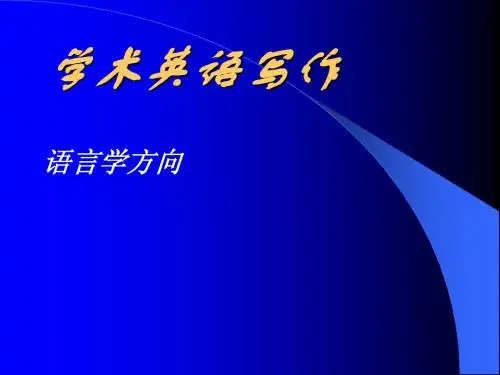
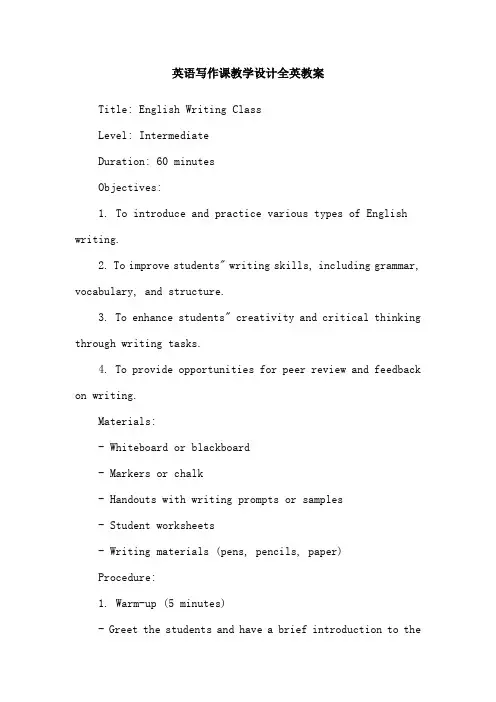
英语写作课教学设计全英教案Title: English Writing ClassLevel: IntermediateDuration: 60 minutesObjectives:1. To introduce and practice various types of English writing.2. To improve students" writing skills, including grammar, vocabulary, and structure.3. To enhance students" creativity and critical thinking through writing tasks.4. To provide opportunities for peer review and feedback on writing.Materials:- Whiteboard or blackboard- Markers or chalk- Handouts with writing prompts or samples- Student worksheets- Writing materials (pens, pencils, paper)Procedure:1. Warm-up (5 minutes)- Greet the students and have a brief introduction to theclass.- Ask students about their experiences with writing in English. What challenges do they face? What do they enjoy about writing? Write their responses on the board.2. Introduction to Writing Types (10 minutes)- Explain the different types of English writing, such as descriptive, narrative, persuasive, and argumentative.- Provide examples of each type and discuss their characteristics.- Ask students to identify the purpose and audience for each type of writing.3. Grammar and Vocabulary Review (15 minutes)- Review relevant grammar points and vocabulary that students can use in their writing.- Use examples and exercises to practice the grammar and vocabulary in context.- Encourage students to ask questions and clarify any doubts they may have.4. Writing Task 1: Descriptive Writing (20 minutes)- Distribute a handout with a descriptive writing prompt or provide a sample paragraph.- Ask students to brainstorm ideas and write a descriptiveparagraph individually.- After the time is up, pair students to exchange and give feedback on each other"s writing.- Discuss some of the best examples as a class and provide feedback.5. Writing Task 2: Persuasive Writing (15 minutes)- Present a persuasive writing prompt or provide a sample paragraph.- Instruct students to write a persuasive paragraph individually.- Pair students again for peer review and feedback.- Discuss the effectiveness of different persuasive techniques used by students.6. Conclusion and Feedback (5 minutes)- Summarize the main points covered in the class.- Ask students to share their thoughts on what they learned and any areas they would like further practice.Extension Activity (optional):- Assign a longer writing task as homework, such as a short story or an argumentative essay.- Provide individual feedback on the students" writing and encourage them to revise and improve it.Note: The timing for each activity may vary depending on the students" level and pace. It is recommended to adjust the activities accordingly.。

Lecture 11.1Features on the lexical level(词汇层面)(1) The analysis didn’t yield any new results. (Informal)The analysis yielded no results. (Formal)(2) These semiconductors can be used in robots, CD players, etc. (Informal)These semiconductors can be used in robots, and CD players. (Formal)1.1.2Nominalization(名词化)(1)[Everyday English]If a potential is applied to gas at low pressure, ionization of the molecules will result. [Academic English]The application of a potential to gas at low pressure will result in ionization of the molecules. (2)[Everyday English]The progress of the work will depend on how modern the equipment is.[Academic English]The progress of the work will depend on the modernization ofthe equipment.1.1.3Hedging(模糊语)(1)On the evidence of the findings presented in Figure 1, it would appear that students in Hong Kong generally have little need to speak in English outside the classroom.(2) Weismann suggested that animals become old because, if they did not, there could be no successive replacement of individuals and hence no evolution.1.1.4 Use of single verbs (使用单一动词)(1)The material amenities of life have gone up in Western society.( increased )(2)A primary education system was set up throughout Ireland as early as 1831.(establish)其他如look into(investigate);get rid of(eliminate)1.2.1大量使用被动语态(1) Any container can be filled by these as they diffuse and spread out to fill them. The atoms or molecules of gases move very rapidly and are widely spaced..(2) Using a simplified input-output (I-O) framework, the aggregate economic output of the non-energy sector (Yt) can be formulated as the sum of value-added in the non-energy sector (Vane,t) and inter-industry payments for energy and transport services.1.2.2客观语言(1)I chose this method because it is less complex. (personal)This method is chosen because it is less complex.(2)The conclusions are appalling and account, to a large extent, for the terrible morbidity and mortality statistics of this community.客观语言,句子改写Text 2This paper presents the findings of an analysis of teamwork development. The group selected for this assignment (the survey team) is a small team of four people working in a small department of Advance Tours. The performance of the team and the team members’ attitudes to their team were measured using two questionnaires developed by Cacioppe (1998). An analysis of the findings is then presented and recommendations are made as to what measures can be employed to improve the overall teamwork and performance of the team.Being brief and concisee.g. (1a) Preliminary observations on the effect of Zn element on anticorrosion(防腐蚀)of zinc plating layer (镀锌层) (wordy)(1b) Effect of Zn on anticorrosion of zinc plating layer (concise)e.g.《中国近代纸币史》中几个学术问题的探讨(2a)Discussion on Several Academic problems in the Book The Modern History of Chinese Paper Money (wordy)(2b)Several Questions in Modern History of Chinese Banknotes (concise)2.3 Keywords(1)Functions of keywordsKeywords of a research paper are the most frequently used words and the most important words and phrases of the paper. They are representative of the theme of the paper. As it mainly functions for easiness of retrieval, “keywords”is also variously called “indexing terms”(索引词), “keywords index”, “keywords and phrases”.(2)Form and number of keywords◇Keywords of research paper appear in the form of nouns, not verbs, For example, “investigation”is used instead of “investigate”.◇In general, the number of keywords ranges from 2 to 8. The normal limited number of keywords is four to six in one paper◇As usual, keywords are chosen from the “title”and/or “abstract”, where the key terms of words and phrases are usually contained(3)Location of keywordsThough keywords can be either above or below the abstract of a paper, they are yet, in most cases, placed below the abstract. They are in lowercase except abbreviations.(4)Methods of spacing keywordsThere are three methods of spacing keywords:using comma ,semicolon ;larger partitionFull stop could not be used to space keywords.如:(1)“software component,(;) UML, (;) rational database”.2.4Common scientific foundation elements in Acknowledgements.1.国家高技术研究发展计划资助项目(863计划)(No.)National High Technology Research and Development Program of China (863 Program) (No.) 2.国家自然科学基金(面上项目:重点项目:重大项目:)No.National Natural Science Foundation of China (General Program; Key Program; Major Program)3.国家教育部博士点基金资助项目(No.)Ph.D Programs Foundation of Ministry of Education of China.4国家重点基础研究发展规划项目(973计划)(No.)The Major State Basic Research Development Program of China (973 program)5. 国家“十一五”攻关项目National Key Technologies R & D Program of China during the 11th Five Year Plan Period (No.)Descriptive Abstract(1) This paper presents an analysis of the principles of magnetic refrigeration with application to air-conditioning. A comparison with conventional evaporation-condensation gas cycle device is presented. Conclusions concerning the applicability of magnetic refrigeration to air conditioning are made.(2) The purpose of this project is to measure environmental equity in Salem, Oregon, with an aim to contribute to a growing body of literature concerned with the unequal distribution of environmental hazards .The project analyzes important previous studies and then conducts an investigation that centers around a series of GIS (Geographic Information System) maps that reveal correlations between environmental hazards and demographics(统计学), such as race and income level. The results will be revealed and discussed.(3) The Postmodern Appeal of complementary and Alternative medicines (CAM) to Australian Consumers: A Review of the LiteratureThe increasing popularity of complementary and alternative medicines (CAM) amongst health consumers and orthodox service providers in Australia is well documented. However, understandings about the reasons for increasing consumer use of CAM in Australia and elsewhere are poorly developed and invite further research.This paper presents the results of a systematic literature review on reasons for CAM use by the Australian population.There are four main themes: 1) criticism of conventional medicine, 2)attraction to the holistic model(整体模型)of health, 3) treatment options for chronic and terminal illness, and 4) lifestyle factors which are identified and explored through social change theory, namely, globalization and post-modernization(4) Mechanism of Angiogenesis(血管生成) and Arteriogenesis (动脉生成)Endothelial(内皮细胞)and smooth music cells interact with each other to form new blood vessels. In this review, the cellular and molecular mechanisms(细胞分子机制)underlying the formation of endothelium-lined channels (angiogenesis) and their maturation via recruitment of smooth muscle cells (arteriogenesis) during physiological and pathological(病理学的)conditions are summarized, alongside with possible therapeutic applications.Informative AbstractThe major components of an informative abstract:(1)PurposeThe purpose of the study introduces the reason, the origin, the importance and significance of the study in question, including the premise, purpose and tasks and scope of the research. The purpose section of an informative abstract might also contain the hypothesis of the experiment.(2)MethodologyResearch methods present the methods or techniques of the research, including the model, theory, conditions, objects, sampling method, sample size,materials, technology, means, equipment, procedures (study design (e.g., survey), data collection and analysis.(3)ResultResults report the results of the study, including data, identified relationship, observation results, effectiveness and performance achieved.(4)ConclusionsConclusions comment on the main contribution or value of the research paper. It includes ananalysis, comparison, evaluation of the research results (e.g. interpret the results as supporting or not supporting the theory or hypotheses), new issues raised, further studies of the future, assumptions, inspirations, recommendations and forecasts.当今绝大部分的科技期刊和会议论文都要求作者提供信息性摘要):信息性摘要主要报道论文的研究目的、研究方法、研究结果与结论。
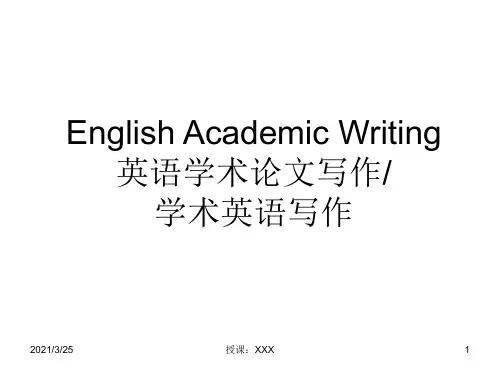

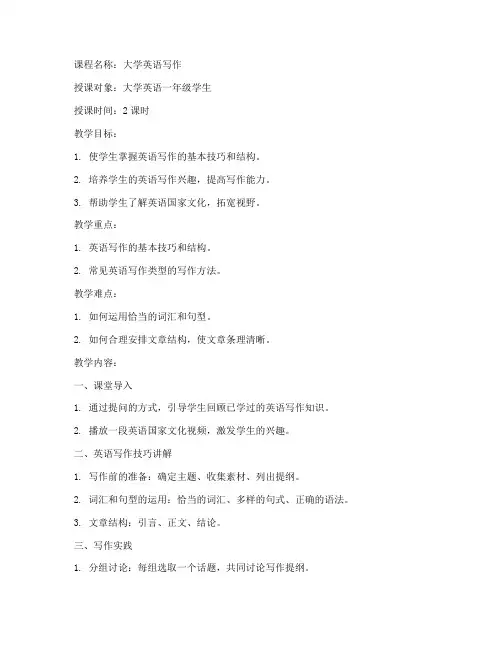
课程名称:大学英语写作授课对象:大学英语一年级学生授课时间:2课时教学目标:1. 使学生掌握英语写作的基本技巧和结构。
2. 培养学生的英语写作兴趣,提高写作能力。
3. 帮助学生了解英语国家文化,拓宽视野。
教学重点:1. 英语写作的基本技巧和结构。
2. 常见英语写作类型的写作方法。
教学难点:1. 如何运用恰当的词汇和句型。
2. 如何合理安排文章结构,使文章条理清晰。
教学内容:一、课堂导入1. 通过提问的方式,引导学生回顾已学过的英语写作知识。
2. 播放一段英语国家文化视频,激发学生的兴趣。
二、英语写作技巧讲解1. 写作前的准备:确定主题、收集素材、列出提纲。
2. 词汇和句型的运用:恰当的词汇、多样的句式、正确的语法。
3. 文章结构:引言、正文、结论。
三、写作实践1. 分组讨论:每组选取一个话题,共同讨论写作提纲。
2. 指导学生进行写作练习,强调写作技巧的运用。
四、课堂小结1. 回顾本节课所学内容,强调写作技巧的重要性。
2. 鼓励学生在课后多加练习,提高写作水平。
教学步骤:第一课时:1. 课堂导入(10分钟)- 提问:同学们,你们在英语写作中遇到过哪些困难?- 播放英语国家文化视频,激发兴趣。
2. 英语写作技巧讲解(20分钟)- 写作前的准备:确定主题、收集素材、列出提纲。
- 词汇和句型的运用:恰当的词汇、多样的句式、正确的语法。
- 文章结构:引言、正文、结论。
3. 写作实践(20分钟)- 分组讨论:每组选取一个话题,共同讨论写作提纲。
- 指导学生进行写作练习,强调写作技巧的运用。
第二课时:1. 课堂小结(10分钟)- 回顾本节课所学内容,强调写作技巧的重要性。
- 鼓励学生在课后多加练习,提高写作水平。
2. 学生展示(20分钟)- 学生自愿展示自己的写作成果,其他同学给予评价和反馈。
- 教师针对学生的写作成果进行点评和指导。
3. 课后作业布置(10分钟)- 学生根据本节课所学内容,完成一篇英语作文。
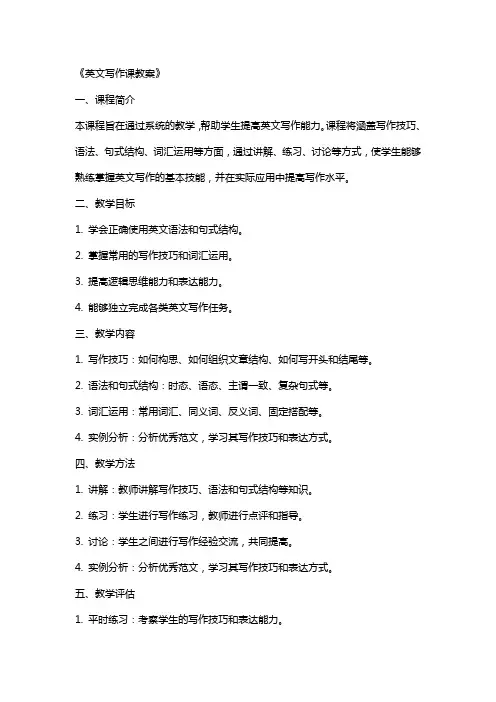
《英文写作课教案》一、课程简介本课程旨在通过系统的教学,帮助学生提高英文写作能力。
课程将涵盖写作技巧、语法、句式结构、词汇运用等方面,通过讲解、练习、讨论等方式,使学生能够熟练掌握英文写作的基本技能,并在实际应用中提高写作水平。
二、教学目标1. 学会正确使用英文语法和句式结构。
2. 掌握常用的写作技巧和词汇运用。
3. 提高逻辑思维能力和表达能力。
4. 能够独立完成各类英文写作任务。
三、教学内容1. 写作技巧:如何构思、如何组织文章结构、如何写开头和结尾等。
2. 语法和句式结构:时态、语态、主谓一致、复杂句式等。
3. 词汇运用:常用词汇、同义词、反义词、固定搭配等。
4. 实例分析:分析优秀范文,学习其写作技巧和表达方式。
四、教学方法1. 讲解:教师讲解写作技巧、语法和句式结构等知识。
2. 练习:学生进行写作练习,教师进行点评和指导。
3. 讨论:学生之间进行写作经验交流,共同提高。
4. 实例分析:分析优秀范文,学习其写作技巧和表达方式。
五、教学评估1. 平时练习:考察学生的写作技巧和表达能力。
2. 作文作业:评估学生的写作水平和进步情况。
3. 考试成绩:考察学生对课程知识的掌握程度。
注意事项:1. 学生需认真听讲,积极参与练习和讨论。
2. 学生需按时完成作文作业,认真对待每一次写作练习。
3. 教师要及时给予学生反馈,指导其不断提高写作水平。
教案编辑专员:[你的名字]六、教学计划第1周:写作技巧概述与构思训练第2周:基本语法和句式结构第3周:词汇积累与运用第4周:开头和结尾的写作技巧第5周:文章组织与逻辑性第6周:优秀范文分析与模仿第7周:写作实践中常见问题与解决方法第8周:总结与复习七、教学资源1. 教材:英文写作教程2. 参考书籍:英文写作手册、语法大全3. 网络资源:英文写作网站、在线语法检查工具4. 范文:优秀范文精选八、教学活动1. 写作技巧讲解:教师讲解各种写作技巧,如如何构思、如何组织文章结构等。
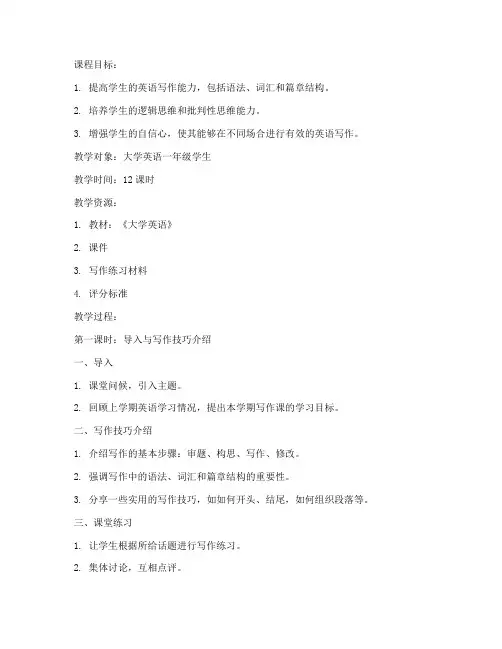
课程目标:1. 提高学生的英语写作能力,包括语法、词汇和篇章结构。
2. 培养学生的逻辑思维和批判性思维能力。
3. 增强学生的自信心,使其能够在不同场合进行有效的英语写作。
教学对象:大学英语一年级学生教学时间:12课时教学资源:1. 教材:《大学英语》2. 课件3. 写作练习材料4. 评分标准教学过程:第一课时:导入与写作技巧介绍一、导入1. 课堂问候,引入主题。
2. 回顾上学期英语学习情况,提出本学期写作课的学习目标。
二、写作技巧介绍1. 介绍写作的基本步骤:审题、构思、写作、修改。
2. 强调写作中的语法、词汇和篇章结构的重要性。
3. 分享一些实用的写作技巧,如如何开头、结尾,如何组织段落等。
三、课堂练习1. 让学生根据所给话题进行写作练习。
2. 集体讨论,互相点评。
第二课时:语法与词汇一、语法讲解1. 讲解写作中常见的语法错误,如时态、语态、主谓一致等。
2. 通过例句讲解语法规则,让学生掌握正确的语法用法。
二、词汇积累1. 介绍写作中常用的词汇,如连接词、过渡词等。
2. 让学生通过造句、翻译等方式练习词汇。
三、课堂练习1. 让学生根据所学语法和词汇进行写作练习。
2. 集体讨论,互相点评。
第三课时:篇章结构一、篇章结构讲解1. 介绍不同类型的文章结构,如总分总、分总等。
2. 讲解段落之间的逻辑关系,如递进、转折等。
二、课堂练习1. 让学生根据所学篇章结构进行写作练习。
2. 集体讨论,互相点评。
第四课时:写作实践一、审题与构思1. 讲解如何审题,明确写作要求。
2. 介绍构思的方法,如头脑风暴、思维导图等。
二、写作实践1. 让学生根据所学知识进行写作实践。
2. 集体讨论,互相点评。
第五课时:修改与润色一、修改方法讲解1. 介绍修改的方法,如检查语法错误、调整篇章结构等。
2. 讲解如何提高文章的可读性。
二、课堂练习1. 让学生根据所学修改方法进行修改练习。
2. 集体讨论,互相点评。
第六课时:写作技巧与范文分析一、写作技巧分析1. 分析优秀范文,总结写作技巧。

英语语言学教学教学教案英语语言学教学教案本教案旨在帮助教师们更好地组织和备课英语语言学课程。
英语语言学作为一门重要的语言学科,对于学生的语言学知识、认知水平和语言运用能力的培养具有重要作用。
为了达到良好的教学效果,我们需要合理安排教学内容和教学方法,以及评估学生的学习成果。
一、教学目标本课程旨在帮助学生:1. 理解英语语言学的基本概念和理论框架;2. 掌握语音、语法、词汇和语义等语言学基本知识;3. 学习英语语言的语用学、社会语言学和心理语言学等相关领域;4. 发展批判性思维和学术研究能力;5. 运用所学知识分析和解决实际问题。
二、教学内容1. 语音学a. 音素和音位的概念b. 音素分类和语音规则c. 声调和重音d. 音变和语音系统2. 语法学a. 句子结构和句法成分b. 语法范畴和语法功能c. 句子类型和语序d. 句法关系和句法分析3. 词汇学a. 词汇的构成和分类b. 词义和词汇关系c. 词汇的记忆和运用d. 词汇的变化和演化4. 语义学a. 词义的理论和模型b. 词义关系和上下位关系c. 语义的语用功能和语境d. 语义分析和语义解释5. 语用学a. 话语的结构和功能b. 言语行为和交际意图c. 礼貌原则和言语策略d. 语用失误和修复机制6. 社会语言学a. 方言和社会变体b. 语言变异和语言变体c. 社会语言学研究方法d. 语言政策和语言规划7. 心理语言学a. 语言认知和语言心理过程b. 语言习得和语言发展c. 语言表征和语言理解d. 语言障碍和语言治疗三、教学方法1. 讲授法:通过课堂讲授介绍英语语言学的基本概念和理论,引导学生建立知识框架。
2. 互动讨论:组织学生参与讨论并提供相关案例分析,培养学生批判性思维和问题解决能力。
3. 小组合作:让学生分组进行小组合作学习,共同完成相关任务和项目,培养团队合作精神。
4. 实践活动:组织学生进行调查研究、实地考察和实践操作,将理论知识应用于实际情境中。
教学目标:1. 培养学生英语写作的基本能力,包括句子结构、段落组织和文章结构。
2. 提高学生的英语写作兴趣,激发学生的创造性思维。
3. 帮助学生掌握不同类型的英语写作技巧,如议论文、说明文、记叙文等。
4. 增强学生的英语写作自信心,提高英语写作成绩。
教学对象:大学英语一年级学生教学时间:2课时教学资源:1. 教材:《大学英语》2. PPT课件3. 课堂练习册4. 网络资源教学过程:第一课时一、导入1. 教师简要介绍本节课的教学目标和内容。
2. 学生自由讨论,分享自己英语写作的困惑和经验。
二、写作技巧讲解1. 句子结构:讲解主语、谓语、宾语、定语、状语等基本成分,强调句子结构的完整性和逻辑性。
2. 段落组织:讲解段落主题句、扩展句、结论句等结构,强调段落之间的连贯性和逻辑性。
3. 文章结构:讲解引言、正文、结论等部分,强调文章整体结构的清晰性和逻辑性。
三、写作练习1. 学生根据所学写作技巧,独立完成一篇短文,内容可以是个人经历、社会现象等。
2. 教师巡视指导,解答学生在写作过程中遇到的问题。
四、课堂讨论1. 学生展示自己的写作成果,其他学生给予评价和反馈。
2. 教师点评,指出学生写作中的优点和不足,并提出改进建议。
第二课时一、复习上节课所学内容1. 教师提问,检查学生对写作技巧的掌握情况。
2. 学生回答问题,巩固所学知识。
二、不同类型写作技巧讲解1. 议论文:讲解论点、论据、论证等结构,强调逻辑性和说服力。
2. 说明文:讲解说明对象、说明方法、说明顺序等结构,强调清晰性和条理性。
3. 记叙文:讲解时间、地点、人物、事件等要素,强调情节的连贯性和生动性。
三、写作练习1. 学生根据所学不同类型写作技巧,独立完成一篇短文。
2. 教师巡视指导,解答学生在写作过程中遇到的问题。
四、课堂讨论1. 学生展示自己的写作成果,其他学生给予评价和反馈。
2. 教师点评,指出学生写作中的优点和不足,并提出改进建议。
教学评价:1. 学生课堂参与度:观察学生在课堂上的发言、讨论和练习情况。
英语写作课优质教案优秀英语写作教学设计一、教学内容本节课选自《新概念英语》第二册第四章,主要内容包括英语写作基本技巧和句子结构多样性。
详细内容涉及定语从句、非限制性定语从句、并列句和复合句运用,以及如何通过这些句型提升写作丰富性和表达力。
二、教学目标1. 让学生掌握基本英语句型和语法结构,提升写作能力。
2. 培养学生运用不同句型表达思想,提高文章连贯性和逻辑性。
三、教学难点与重点教学难点:定语从句、非限制性定语从句、并列句和复合句正确运用。
教学重点:如何通过这些句型提升写作丰富性和表达力。
四、教具与学具准备1. 教师准备:PPT、黑板、粉笔、示例文章。
2. 学生准备:笔记本、教材、文具。
五、教学过程1. 实践情景引入(5分钟)通过展示一篇关于旅行范文,引导学生关注文章中不同句型和表达方式。
2. 例题讲解(15分钟)分析范文中定语从句、非限制性定语从句、并列句和复合句,并进行讲解。
3. 随堂练习(10分钟)让学生模仿范文,运用所学句型进行写作练习。
4. 互动讨论(10分钟)学生相互评价写作练习,教师点评并给予建议。
6. 课堂小结(5分钟)对本节课内容进行回顾,强调重点和难点。
六、板书设计1. 定语从句、非限制性定语从句、并列句和复合句示例。
2. 写作技巧和注意事项。
七、作业设计1. 作业题目:以“我梦想”为主题,运用所学句型写一篇短文。
2. 答案示例:Teachers play a crucial role in shaping students' future. (Complex sentence)I enjoy helping others, which is one of my strengths. (Restrictive attributive clause)Additionally, I am patient, a quality necessary for this career. (Nonrestrictive attributive clause)In conclusion, I will strive to achieve my dream and make a difference in education. (Concluding sentence)八、课后反思及拓展延伸1. 课后反思:关注学生对句型掌握程度,调整教学方法,提高教学效果。
学术英语教案Academic English, as a discipline, is not merely a set of grammatical rules or a vocabulary list to be memorized; it is a means of communication that facilitates the sharing and construction of knowledge in academic settings. This article aims to outline an effective approach to teaching Academic English, focusing on the integration of language skills with critical thinking and academic practices.Understanding Academic English。
Academic English differs from everyday English in several ways. It is more formal, structured, and often utilizes a specialized vocabulary. Understanding this, educators must approach its teaching with a clear strategy that encompasses the unique features of academic discourse. This includes the use of complex sentences, passive voice, nominalization, and the precise use of terminology.Developing Language Skills。
教案名称:大学英语写作课课时:2课时(90分钟)年级:大一教学目标:1. 帮助学生掌握英语写作的基本技巧和策略。
2. 提高学生的英语表达能力,培养良好的写作习惯。
3. 增强学生的英语语法和词汇运用能力。
4. 培养学生的批判性思维和创造性思维。
教学内容:1. 写作技巧和策略:如何构思、如何组织文章结构、如何进行开头和结尾、如何使用过渡语等。
2. 英语语法和词汇的运用:时态、语态、句型、同义词和反义词等。
3. 批判性思维和创造性思维的培养:如何进行逻辑推理、如何提出观点和论证、如何进行创新表达等。
教学过程:第一课时:一、导入(10分钟)教师通过向学生提问,了解他们对英语写作的认识和困惑,激发学生的学习兴趣。
二、写作技巧讲解(20分钟)1. 教师讲解如何构思和组织文章结构,强调开头和结尾的重要性。
2. 教师讲解如何使用过渡语,使文章连贯流畅。
三、语法和词汇讲解(20分钟)1. 教师讲解时态和语态的运用,举例说明。
2. 教师讲解句型的运用,如主谓宾结构、定语从句等。
3. 教师讲解同义词和反义词的运用,提高学生的词汇水平。
四、批判性思维和创造性思维讲解(10分钟)1. 教师讲解如何进行逻辑推理,提出观点和论证。
2. 教师讲解如何进行创新表达,培养学生的创造性思维。
第二课时:一、写作实践(20分钟)教师给出一个写作话题,学生根据所学的写作技巧和策略,进行写作实践。
二、小组讨论(15分钟)学生分组,互相交换写作作品,进行小组讨论,提出修改意见和建议。
三、修改和润色(15分钟)学生根据小组讨论的结果,对自己的写作作品进行修改和润色。
四、总结和反馈(15分钟)教师对学生的写作作品进行点评,给予积极的反馈和建设性的意见,帮助学生提高写作能力。
教学评价:1. 学生写作作品的质量,包括内容、结构、语法和词汇的运用。
2. 学生在小组讨论中的表现,包括批判性思维和创造性思维的运用。
3. 学生对写作技巧和策略的掌握程度。
教学资源:1. 教材:大学英语写作教程。
学术英语课程设计一、课程目标知识目标:1. 学生能够掌握学术英语的基本词汇和表达方式,理解并运用相关语法知识;2. 学生能够掌握学术英语文章的结构和特点,提高阅读理解能力;3. 学生能够运用所学知识,分析并评价英文学术文章。
技能目标:1. 学生能够运用批判性思维,对学术英语文章进行深入分析;2. 学生能够独立完成学术英语文章的阅读与理解,提高阅读速度和效率;3. 学生能够运用所学知识,进行学术英语写作,提高写作能力。
情感态度价值观目标:1. 培养学生对学术英语的兴趣和热情,激发学习积极性;2. 培养学生的团队协作精神,学会与他人分享和交流学术观点;3. 增强学生的跨文化意识,尊重并理解不同文化背景下的学术观点。
课程性质:本课程为学术英语课程,旨在提高学生的英语学术素养,培养其批判性思维和跨文化交际能力。
学生特点:学生处于高中阶段,具有一定的英语基础,对学术英语有一定了解,但阅读和写作能力有待提高。
教学要求:结合课本内容,注重理论与实践相结合,采用启发式教学,提高学生的主动性和参与度。
将课程目标分解为具体的学习成果,以便于教学设计和评估。
二、教学内容本课程教学内容分为五个单元,每个单元对应课本的相应章节:第一单元:学术英语词汇与表达1. 掌握学术英语常用词汇和短语;2. 学习并运用学术英语的常用句型和语法结构。
第二单元:学术英语阅读技巧1. 分析学术英语文章的结构和特点;2. 学习并运用阅读策略,提高阅读速度和理解能力。
第三单元:批判性思维与学术分析1. 学习批判性思维方法,对学术文章进行深入分析;2. 运用批判性思维,评价和讨论学术观点。
第四单元:学术英语写作技巧1. 学习学术英语写作的基本框架和规范;2. 掌握学术英语写作的常用表达和句型。
第五单元:跨文化交际与学术交流1. 了解不同文化背景下的学术交流特点;2. 学习并运用跨文化交际技巧,进行学术讨论和交流。
教学内容安排和进度:1. 每个单元分配一周时间,共计五周;2. 每周进行一次课堂讨论,加强师生互动和生生互动;3. 结合课本章节内容,制定详细的教学大纲,确保教学内容的科学性和系统性。